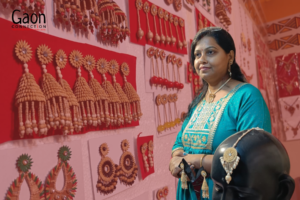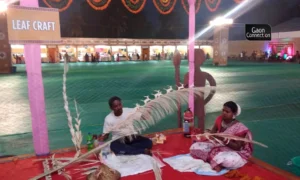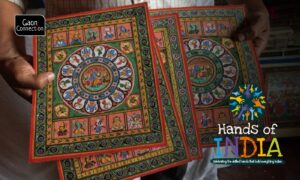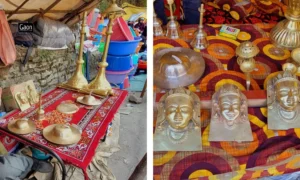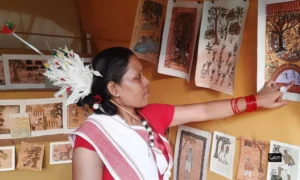Jaipur, Rajasthan
Rajasthan, with its sand dunes and wandering minstrels, holy groves and war heroes, just lends itself to fantastic lore, stirring music, and, therefore, vibrant art.
Art was largely used in the realm of entertainment, as a backdrop to storytelling, puppet shows, hari kathaas, and in other socio-religious activities in Rajasthan. But with the advent of technology, these activities have begun to fade and along with the art forms that were an integral part of them.
The art traditions of Molela, Kaavad and Phad that have all have their origins in religious rituals, but are struggling to survive with their practitioners trying hard to remain relevant. But, the artists say, often, it looks like a losing battle.
The Molela art of potters
In Molela, a nondescript village in Rajsamand district, south of Rajasthan, is a community of artists who draw their inspiration from an 800-year-old folk tale.
As the story goes, Devnarayan, a deity appeared in a dream to a blind kumbhar (potter) and instructed him to make idols of gods and goddesses from a particular kind of mud available in the village and assured him that he would regain his eyesight if he did so. The kumbhar followed the instructions, and got his vision back. And so began the tradition of Molela art.
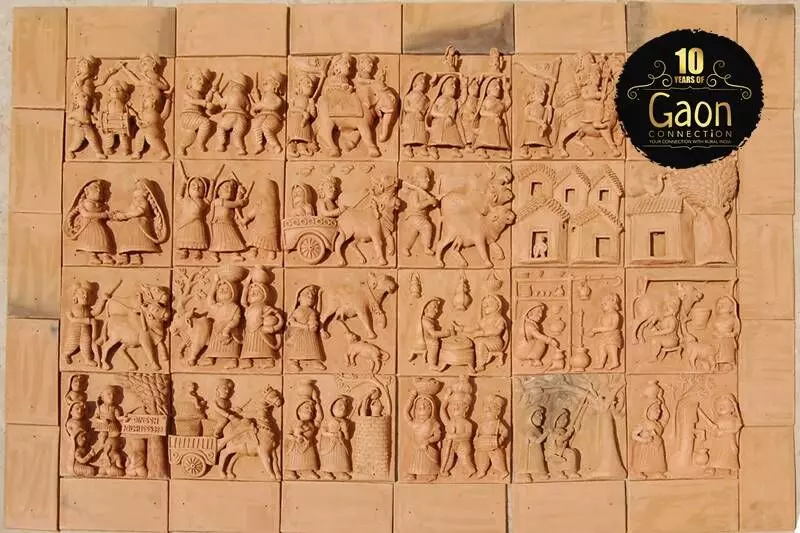
The artist creates images of gods and goddesses on a flat surface like a tile or a plaque that is traditionally installed in temples.
Also Read: Dhokra art of Odisha keeps tribal myths and folklore alive in metal
The ‘special mud’ the folk deity had asked the blind Kumbhar to use is the clay found in Molela village that is mixed with the dung of donkeys or horses. The mixture is kneaded for hours before it is ready to be shaped into the idols that are baked for eight hours in the oven.
According to Molela artist, Dinesh Chand Kumbhar, this religious art is particularly sought after in the Mewar region where Adivasi devotees of Devnarayan travel miles on foot to Molela, buy the idols from the artists and carry them back to their villages, singing and dancing all the way.
“Fairs are held around the temples and the entire village comes to worship there and take part in the festivities,” Dinesh Chand told Gaon Connection. While the art continues to be integral to the traditional practices, it has also moved out of the confines of religion.
“There is no survival without innovation and experiment, and we have evolved from folk deities and moved on to relatively modern subjects such as Meera Bai and Maharana Pratap, besides of course reproducing stories from the Ramayana and the Mahabharata,” Dinesh Chand said.
Also Read: The Banana Fibre Weavers of Anegundi
Molela art is becoming a kind of documentation, he smiled. “When my father first travelled by air, he asked me to tell the story through my art, of a village man travelling by air for the first time and the obstacles he faced,” the artist recalled. “It took me a few weeks to complete that, but I think, was the beginning of the transformation of the art,” he said.

The ‘special mud’ the folk deity had asked the blind Kumbhar to use is the clay found in Molela village that is mixed with the dung of donkeys or horses.
Molela art is also being used as large friezes. “Sometimes the orders are large and it takes us weeks to complete. I recently completed a project for the Udaipur railway station and it took me nearly two months to finish,” said Dinesh Chand.
Some of the Molela artists are travelling the world and getting orders from across the globe. They have adapted their old folk art into contemporary themes, that is paying rich dividends.
But not all have been able to do that, said Dinesh Chand. Many of his fellow artists have quit and have taken up regular jobs where there is a steady income.
Also Read: Bihar’s Tikuli art: From adorning women to empowering them
The Molela artists are concerned about the fast dwindling clay of the village that is a vital ingredient of their art. Brick kilns have sprung up everywhere and the rampant mining will soon exhaust it, the artists fear.
“We wrote to the chief minister to stop this mining. The government must at least stop issuing licences for mining in our village. Otherwise the art will die,” he said.
The Art of Kaavad
About 400 odd kilometres north of Molela is the village of Bassi in Chittorgarh district, where also exists an old art form called Kaavad.
Kaavad is made up of colourful painted panels hinged together. It was used as a backdrop to story telling sessions as narrators regaled the audiences with the tales of heroic deeds of epic heroes in the Ramayana and the Mahabharata, besides the miracles of local folk gods.

The days of Kaavad art may be numbered with no support from the government and the lack of interest from the younger generation.
But with modern lifestyles, the art of Kaavad dimmed. Storytelling is now in the realm of technology. No one has the time or the inclination for leisurely community-activities such as theatre, kathaas and so on. And there are barely five people who still practise this art in Bassi.
Also Read: Colours of Communal Harmony in West Bengal’s Pattachitra Art
“Much of these traditional arts have lost their relevance in the modern age,” Madan Meena, anthropologist and honorary director of Adivasi Academy, Tejgadh, Gujarat, told Gaon Connection. He said that while some of the artists have managed to give their art a new shape, the soul and faith that drove the artists of yore is forever lost.
Kaavad artist Satyanarayana Suthar from Bassi, who won the national award in 2014 acknowledges this but also recognises the fact that reinvention is the only way forward.
“Old ways are important but will not be enough for survival. I have started experimenting with Kaavad,” Satyanarayana told Gaon Connection.
He now makes Kaavads that tell stories of celebrities, or is even adapted into cupboard doors and such. “The idea is to have art on something that is also useful. I have to do this in order to continue with the art form,” he said.
The traditional Kaavad is usually purchased by the Kaavadiya Bhat (storytellers) from Marwar who perform Kaavad in different villages on invitation of their patrons. The usual sizes of these panels range from 12 inches to two feet but as the times have changed, their size has grown to as much as 20 feet.
“I design Kaavads on order. Recently, I made a Kaavad for an Indian couple in Singapore and painted their journey from India to Singapore. The panels now adorn a cupboard there and tell a story,” Satyanarayana said.
Also Read: A handful of artistes strive to revive the centuries old Paitkar art from Jharkhand
Kaavad artists also face a shortage of wood from the Adusa (commonly known as the Malabar nut) they use. Strict forest laws have made it difficult to source the wood.

The Phad art tradition was once jealously guarded and only family members were privy to the art form.
“The wood from the Adusa tree is light and is termite-resistant. But over the years it has become increasingly difficult to get this wood. We have to go through a lot of red tape to get the wood. This is also one of the reasons that Kaavad artists are quitting the art,” Suthar explained.
Kaavad artist Dwarka Prasad Suthar, from Bassi received the President’s award in 2019.
“If we want to survive on this art we need to move out of the villages. If we use Kaavad art in creating cupboards or toys, we can make good money. I make Kaavad for clients all over India,” Dwarka Prasad told Gaon Connection.
The days of this art may be numbered with no support from the government and the lack of interest from the younger generation.
“To keep Kaavad alive, the new generation should take interest. But that is sadly lacking. Not more than five artisans are left who are still practising this art form,” said Dwarka Prasad. Many of them have now shifted to clerical work, construction labour or farming to earn a stable income, he said.
The Phad Paintings
Like it was with Molela and Kaavad art, Phad painting from Bhilwara, in south-central Rajasthan, said to be 700 years old, was also a medium of storytelling.
Stories of gods and goddesses, especially Devnarayan and Pabuji were painted on 40-feet-long cloth, and this was a prop to the balladeers or Bhopa (from the Rebari clans) who sang or narrated the stories to their audience.
The art of creating the phad on the cotton cloth belongs to the Joshi lineage of the Chippa caste. The artists of the Joshi community were commissioned by the Bhopas, to make the cloth painting.

Though new experiments are keeping this old art form alive its traditional depiction is fast disappearing. The art of painting the stories of Devnarayan and Bapuji on 40-foot cloth is something only four or five people do.
“If we will just stick to old traditions, the art will not survive and neither will we. And, nowadays, houses are not large enough to accommodate 30-40 feet long Phads,” pointed out Kalyan Joshi, a renowned Phad artist. So now the brush strokes adorn designer clothes, smaller wall paintings, coasters, pottery, and so on.
“Recently, a multinational company ordered 500 small Phad paintings that it wanted to gift its employees on Diwali. I have even painted on the walls of the Bhilwara railway station,” Joshi told Gaon Connection.
Also Read: A veteran artist is using traditional Phad paintings to raise awareness on COVID-19 in Rajasthan
The Phad art tradition was once jealously guarded and only family members were privy to the art form. But Joshi broke this tradition and runs an art school called Chitrashala, where anyone can learn the art.
“I have trained more than 4,000 students. Many have started their own business. Some are experimenting with this art in fashion designing, tile paintings, crockery and interior decoration,” he said.
It has been this willingness to step out of the confines of tradition that has allowed him and to an extent the art to survive. “I would not have managed if I had stuck to the old methods,” Kalyan said. “There is a curiosity amongst the young people to learn more about this art form and for that I am grateful,” he added.
Though new experiments are keeping this old art form alive its traditional depiction is fast disappearing. The art of painting the stories of Devnarayan and Bapuji on 40-foot cloth is something only four or five people do.
With technology’s advent, patience has disappeared, Kalyan said. “I believe that in the coming years there will be no one left to make the original devotional Phads for our folk deities. This is sad, but the new generation is taking forward this tradition on their terms,” he said.

The art traditions of Molela, Kaavad and Phad that have all have their origins in religious rituals, but are struggling to survive with their practitioners trying hard to remain relevant. But, the artists say, often, it looks like a losing battle.
“These art forms are ritualistic and have a direct relationship to the religious practices of the communities which patronised them. But that is no more the case,” Madan Meena said. “And, even though commercialisation has to an extent put some of the artists in a good place, there is still a lot to be done for the others,” the anthropologist pointed out.
Also Read: ‘Words have their own burden but art is fluid’
The Ministry of Textile has started an entrepreneurship development programme for the artisans in 2021.
“Many artists are innovating their work and we have given them a platform to move ahead. Artisans are given financial support up to Rs 5 lakh and special training to impart entrepreneurship skills in them,” Manohar Meena, Handicraft Promotion Officer at the handicrafts service centre, Udaipur, told Gaon Connection.
“Our purpose has always been to make the art form marketable and help the artisans develop their art form as per the taste of the public. This helped them grow financially and take their art to different corners of the world,” he said.







